The Darkness that Comes Before (89 page)
Read The Darkness that Comes Before Online
Authors: R. Scott Bakker

A cabal of magi and generals that survived the death of the No-God in 2155 and has laboured ever since to bring about his return in the so-called Second Apocalypse. Very few in the Three Seas believe the Consult still exists.
The SchoolsA collective name given to the various academies of sorcerers. The first Schools, both in the Ancient North and in the Three Seas, arose as a response to the Tusk’s condemnation of sorcery. The Schools are among the oldest institutions in the Three Seas, and they survive, by and large, because of the terror they inspire and their detachment from the secular and religious powers of the Three Seas.
The Mandate
—Gnostic School founded by Seswatha in 2156 to continue the war against the Consult and to protect the Three Seas from the return of the No-God, Mog-Pharau.
—Gnostic School founded by Seswatha in 2156 to continue the war against the Consult and to protect the Three Seas from the return of the No-God, Mog-Pharau.
Nautzera,
senior member of the Quorum
senior member of the Quorum
Simas,
member of the Quorum and Achamian’s former teacher
member of the Quorum and Achamian’s former teacher
Seswatha,
survivor of the Old Wars and ancient founder of the Mandate
survivor of the Old Wars and ancient founder of the Mandate
The Scarlet Spires
—Anagogic School that is the most powerful in the Three Seas and has been de facto ruler of High Ainon since 3818.
—Anagogic School that is the most powerful in the Three Seas and has been de facto ruler of High Ainon since 3818.
Eleäzaras,
Grandmaster of the Scarlet Spires
Grandmaster of the Scarlet Spires
Iyokus,
Eleäzaras’s Master of Spies
Eleäzaras’s Master of Spies
Geshrunni,
slave-soldier and momentary Mandate spy
slave-soldier and momentary Mandate spy
The Imperial Saik
—Anagogic School indentured to the Emperor of Nansur.
—Anagogic School indentured to the Emperor of Nansur.
Cememketri,
Grandmaster of the Imperial Saik
Grandmaster of the Imperial Saik
The Mysunsai
—Self-proclaimed Mercenary School that sells its sorcerous services across the Three Seas.
—Self-proclaimed Mercenary School that sells its sorcerous services across the Three Seas.
Skalateas,
mercenary sorcerer
The Inrithi Factionsmercenary sorcerer
Synthesizing monotheistic and polytheistic elements, Inrithism, the dominant faith of the Three Seas, is founded on the revelations of Inri Sejenus (c. 2159-2202), the Latter Prophet. The central tenets of Inrithism deal with the immanence of the God in historical events, the unity of the individual deities of the Cults as Aspects of the God as revealed by the Latter Prophet, and the infallibility of the Tusk as scripture.
The Thousand Temples
—An institution that provides the ecclesiastical framework of Inrithism. Though based in Sumna, the Thousand Temples is omnipresent throughout the Northwestern and Eastern Three Seas.
—An institution that provides the ecclesiastical framework of Inrithism. Though based in Sumna, the Thousand Temples is omnipresent throughout the Northwestern and Eastern Three Seas.
Maithanet,
Shriah of the Thousand Temples
Shriah of the Thousand Temples
Paro Inrau,
Shrial Priest and former student of Achamian
Shrial Priest and former student of Achamian
The Shrial Knights
—A monastic military order under the direct command of the Shriah, created by Ekyannus III, “the Golden,” in 2511.
—A monastic military order under the direct command of the Shriah, created by Ekyannus III, “the Golden,” in 2511.
Incheiri Gotian,
Grandmaster of the Shrial Knights
Grandmaster of the Shrial Knights
Cutias Sarcellus,
First Knight-Commander of the Shrial Knights
First Knight-Commander of the Shrial Knights
The Conriyans
—Conriya is a Ketyai nation of the Eastern Three Seas. Founded after the collapse of the Eastern Ceneian Empire in 3372, it is based around Aöknyssus, the ancient capital of Shir.
—Conriya is a Ketyai nation of the Eastern Three Seas. Founded after the collapse of the Eastern Ceneian Empire in 3372, it is based around Aöknyssus, the ancient capital of Shir.
Nersei Proyas,
Prince of Conriya and former student of Achamian
Prince of Conriya and former student of Achamian
Krijates Xinemus,
Achamian’s friend and Marshal of Attrempus
Achamian’s friend and Marshal of Attrempus
Nersei Calmemunis,
leader of the Vulgar Holy War
leader of the Vulgar Holy War
The Nansur
—The Nansur Empire is a Ketyai nation of the Western Three Seas and the self-proclaimed inheritor of the Ceneian Empire. At the height of its power, the Nansur Empire extended from Galeoth to Nilnamesh, but it has been much reduced by centuries of warfare against the Fanim of Kian.
—The Nansur Empire is a Ketyai nation of the Western Three Seas and the self-proclaimed inheritor of the Ceneian Empire. At the height of its power, the Nansur Empire extended from Galeoth to Nilnamesh, but it has been much reduced by centuries of warfare against the Fanim of Kian.
Ikurei Xerius III,
Emperor of Nansur
Emperor of Nansur
Ikurei Conphas,
Exalt-General of Nansur and nephew to the Emperor
Exalt-General of Nansur and nephew to the Emperor
Ikurei Istriya,
Empress of Nansur and mother of the Emperor
Empress of Nansur and mother of the Emperor
Martemus,
General and Aide-de-Camp to Conphas
General and Aide-de-Camp to Conphas
Skeaös,
the Emperor’s Prime Counsel
the Emperor’s Prime Counsel
The Galeoth
—Galeoth is a Norsirai nation of the Three Seas, the so-called Middle-North, founded around 3683 by the descendants of refugees from the Old Wars.
—Galeoth is a Norsirai nation of the Three Seas, the so-called Middle-North, founded around 3683 by the descendants of refugees from the Old Wars.
Coithus Saubon,
Prince of Galeoth and leader of the Galeoth contingent
Prince of Galeoth and leader of the Galeoth contingent
Kussalt,
Saubon’s groom
Saubon’s groom
Coithus Athjeäri,
Saubon’s nephew
Saubon’s nephew
The Tydonni
—Ce Tydonn is a Norsirai nation of the Eastern Three Seas. It was founded after the collapse of the Ketyai nation of Cengemis in 3742.
—Ce Tydonn is a Norsirai nation of the Eastern Three Seas. It was founded after the collapse of the Ketyai nation of Cengemis in 3742.
Hoga Gothyelk,
the Earl of Agansanor and leader of the Tydonni contingent
the Earl of Agansanor and leader of the Tydonni contingent
The Ainoni
—High Ainon is the pre-eminent Ketyai nation of the Eastern Three Seas. It was founded after the collapse of the Eastern Ceneian Empire in 3372 and has been ruled by the Scarlet Spires since the end of the Scholastic Wars in 3818.
—High Ainon is the pre-eminent Ketyai nation of the Eastern Three Seas. It was founded after the collapse of the Eastern Ceneian Empire in 3372 and has been ruled by the Scarlet Spires since the end of the Scholastic Wars in 3818.
Chepheramunni,
King-Regent of High Ainon and leader of the Ainoni contingent
King-Regent of High Ainon and leader of the Ainoni contingent
The Thunyeri
—Thunyerus is a Norsirai nation of the Three Seas. It was founded through the federation of the Thunyeri tribes around 3987, and it only recently converted to Inrithism.
—Thunyerus is a Norsirai nation of the Three Seas. It was founded through the federation of the Thunyeri tribes around 3987, and it only recently converted to Inrithism.
Skaiyelt,
Prince of Thunyerus and leader of the Thunyeri contingent
Prince of Thunyerus and leader of the Thunyeri contingent
Yalgrota,
Skaiyelt’s giant bondsman
The Fanim FactionsSkaiyelt’s giant bondsman
Strictly monotheistic, Fanimry is an upstart faith founded on the revelations of the Prophet Fane (3669-3742) and restricted to the Southwestern Three Seas. The central tenets of Fanimry deal with the singularity and transcendence of the God, the falseness of the Gods (who are considered demons by the Fanim), the repudiation of the Tusk as unholy, and the prohibition of all representations of the God.
The Kianene
—Kian is the most powerful Ketyai nation of the Three Seas. Extending from the southern frontier of the Nansur Empire to Nilnamesh, it was founded in the wake of the White Jihad, the holy war waged by the first Fanim against the Nansur Empire from 3743 to 3771.
—Kian is the most powerful Ketyai nation of the Three Seas. Extending from the southern frontier of the Nansur Empire to Nilnamesh, it was founded in the wake of the White Jihad, the holy war waged by the first Fanim against the Nansur Empire from 3743 to 3771.
Kascamandri,
Padirajah of Kian
Padirajah of Kian
Skauras,
Sapatishah-Governor of Shigek
Sapatishah-Governor of Shigek
The Cishaurim
—Priest-sorcerers of the Fanim, based in Shimeh. Little is known about the metaphysics of Cishaurim sorcery, or the Psûkhe, as the Cishaurim refer to it, beyond the fact that it cannot be perceived by the Few, and that it is in many ways as formidable as the Anagogic sorcery of the Schools.
—Priest-sorcerers of the Fanim, based in Shimeh. Little is known about the metaphysics of Cishaurim sorcery, or the Psûkhe, as the Cishaurim refer to it, beyond the fact that it cannot be perceived by the Few, and that it is in many ways as formidable as the Anagogic sorcery of the Schools.
Seökti,
Heresiarch of the Cishaurim
Heresiarch of the Cishaurim
Mallahet,
powerful member of the Cishaurim
The Major Languages and Dialects of Eärwapowerful member of the Cishaurim
Until the Breaking of the Gates and the migration of the Four Nations from Eänna, the Men of Eärwa, called the Emwama in
The Chronicle of the Tusk,
were enslaved by the Nonmen and spoke debased versions of their masters’ tongues. No trace of these languages remain. Nor does any trace of their original, pre-bondage language remain. The great Nonman history, the
Isûphiryas,
or the “Great Pit of Years,” suggests the Emwama originally spoke the same tongue as their kin across the Great Kayarsus. This has led many to believe that Thoti-Eännorean is indeed the primeval language of all men.
The Chronicle of the Tusk,
were enslaved by the Nonmen and spoke debased versions of their masters’ tongues. No trace of these languages remain. Nor does any trace of their original, pre-bondage language remain. The great Nonman history, the
Isûphiryas,
or the “Great Pit of Years,” suggests the Emwama originally spoke the same tongue as their kin across the Great Kayarsus. This has led many to believe that Thoti-Eännorean is indeed the primeval language of all men.
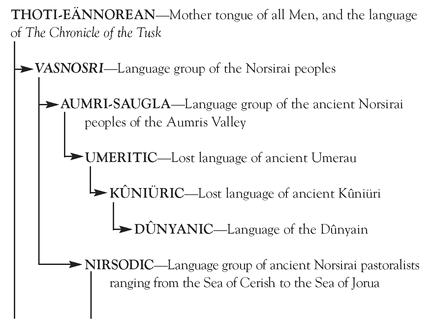
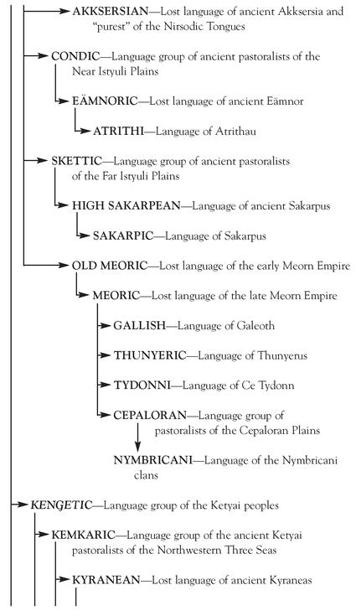
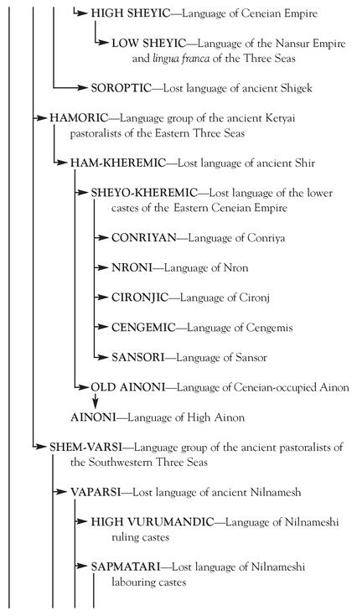
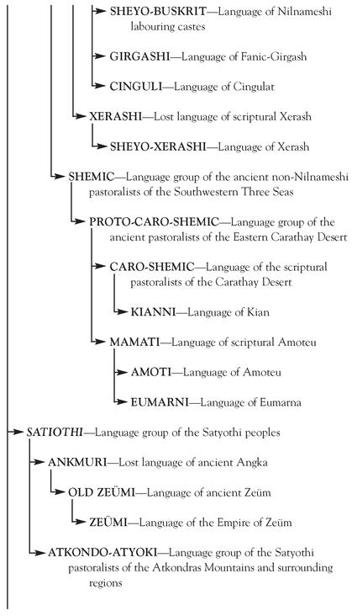
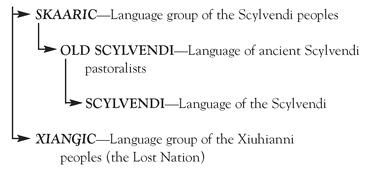
Without doubt, the Nonmen, or Cûnuroi, tongues are among the oldest in Eärwa. Some Aujic inscriptions predate the first extant example of Thoti-Eännorean,
The Chronicle of the Tusk,
by more than five thousand years. Auja-Gilcûnni, which has yet to be deciphered, is far older still.
The Chronicle of the Tusk,
by more than five thousand years. Auja-Gilcûnni, which has yet to be deciphered, is far older still.
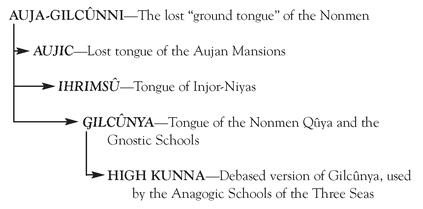
Other books
She's No Angel by Kira Sinclair
Still Waters by Ash Parsons
Wynne's War by Aaron Gwyn
His Brother's Wife by Lily Graison
Miss Armistead Makes Her Choice by Heidi Ashworth
Seeking Vengeance by McDonald, M.P.
I'd Tell You I Love You But Then I'd Have to Kill You by Ally Carter
Cold Hearted Son of a Witch (Dragoneers Saga) by Mathias, M. R.
Missing Lynx by Quinn, Fiona
Double Feature by Erika Almond
